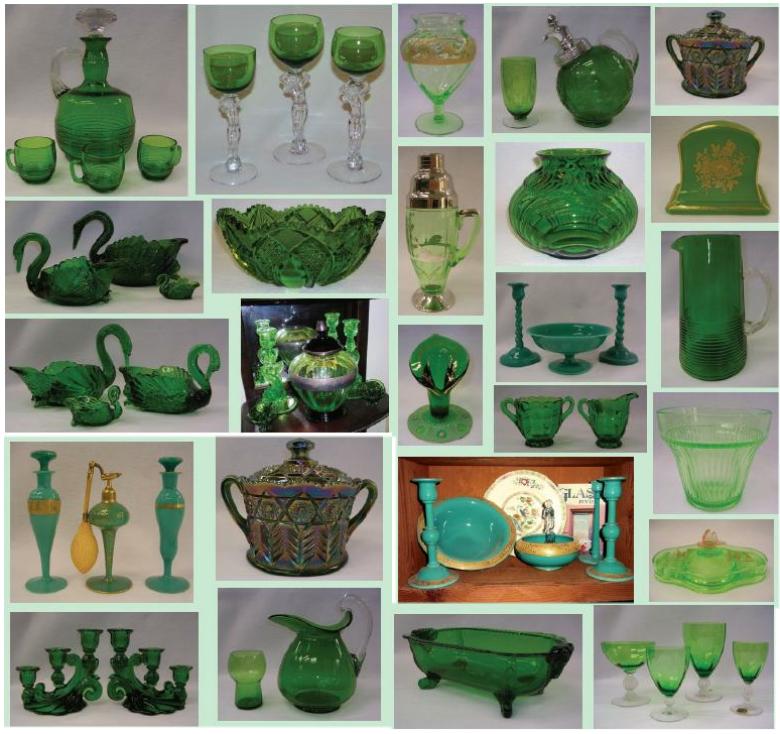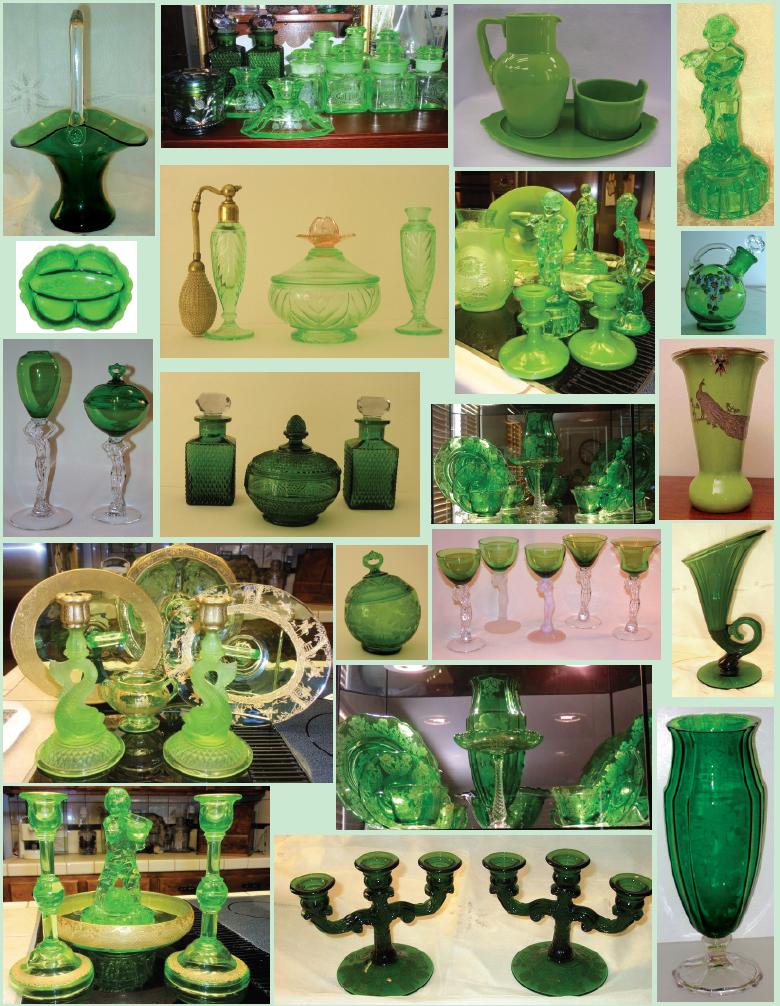Shades of Green
by David Ray
Issue No. 435 - February 2010
During its 57-year run, the Cambridge Glass Company produced nine differing green colors of glassware – "Early Green", Early Dark Emerald, Jade, Light Emerald, Avocado, Forest Green, Pistachio, Late Dark Emerald, and "Odd Green". Except for the period from 1944 to 1948, the Cambridge Glass Company continuously produced at least one green color of glass. Although simultaneously producing green glassware, other elegant glass companies had green colors that will seldom be confused with the green colors of the Cambridge Glass Company.
The first reference of green glass produced by Cambridge was
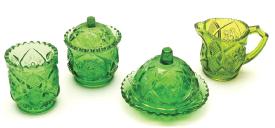 in 1903, and this green color is referred to as "Early Green"
by Cambridge glass collectors. Production appears to have
been limited to children's toy table settings, which consisted
of a sugar, a creamer, a spooner, and a round covered butter
dish. Frequently, these 4-piece settings possess a wide range
of variation of green color, and no clear explanation exists for
the color variation; however, some believe the color variation
is likely due to poor quality control during early years of
the Cambridge Glass Company. Nearly all 4-piece settings
seem to have at least three shades of green. Early Green was
discontinued before 1916.
in 1903, and this green color is referred to as "Early Green"
by Cambridge glass collectors. Production appears to have
been limited to children's toy table settings, which consisted
of a sugar, a creamer, a spooner, and a round covered butter
dish. Frequently, these 4-piece settings possess a wide range
of variation of green color, and no clear explanation exists for
the color variation; however, some believe the color variation
is likely due to poor quality control during early years of
the Cambridge Glass Company. Nearly all 4-piece settings
seem to have at least three shades of green. Early Green was
discontinued before 1916.
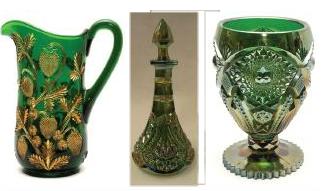 In 1916, the Cambridge Glass Company introduced a more
vibrant shade of green and called it Emerald. Since the color
name of Emerald was used by Cambridge for a similar dark
green color introduced in 1949, collectors refer to this Emerald
as Early Dark Emerald. Many of the Near Cut patterns were
produced in this color, but most items have the carnival
treatment. The Near Cut patterns include: Strawberry, Thistle,
Marjorie, Feather, Buzz Saw, and Wheat Sheath. Finding
Early Dark Emerald items in Near Cut patterns without the
carnival treatment is difficult, with the exception of Thistle.
However, most of the Thistle pieces in Early Dark Emerald
have the pattern highlighted with gold. Early Dark Emerald
was discontinued before 1923.
In 1916, the Cambridge Glass Company introduced a more
vibrant shade of green and called it Emerald. Since the color
name of Emerald was used by Cambridge for a similar dark
green color introduced in 1949, collectors refer to this Emerald
as Early Dark Emerald. Many of the Near Cut patterns were
produced in this color, but most items have the carnival
treatment. The Near Cut patterns include: Strawberry, Thistle,
Marjorie, Feather, Buzz Saw, and Wheat Sheath. Finding
Early Dark Emerald items in Near Cut patterns without the
carnival treatment is difficult, with the exception of Thistle.
However, most of the Thistle pieces in Early Dark Emerald
have the pattern highlighted with gold. Early Dark Emerald
was discontinued before 1923.
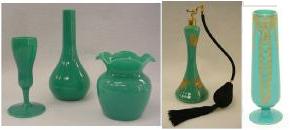 In 1924, the Cambridge Glass Company introduced the
first opaque green glassware, and the color was called Jade.
Although identified as a green color, Jade possesses strong
"blue" undertones. Many very desirable items were produced
in Jade. These include atomizers, perfumes, the ram's head
bowl, and decorated pieces including etchings and enamels.
The majority of the items produced in Jade can also be found
in the other opaque colors produced during the 1920's.
In 1924, the Cambridge Glass Company introduced the
first opaque green glassware, and the color was called Jade.
Although identified as a green color, Jade possesses strong
"blue" undertones. Many very desirable items were produced
in Jade. These include atomizers, perfumes, the ram's head
bowl, and decorated pieces including etchings and enamels.
The majority of the items produced in Jade can also be found
in the other opaque colors produced during the 1920's.
In 1923, the Cambridge Glass Company introduced another
new green color also called Emerald. In a 1976 Crystal Ball
article, Lynn Welker coined the name Light Emerald. Lynn
stated that factory workers referred to Light Emerald as "Apple
Green". Light Emerald was produced extensively until the
early 1940's. Obviously, Light Emerald was an extremely
popular color with the buying public because of the large
quantities that can be found today. Some of the major lines
produced in Light Emerald are Decagon, Weatherford, Round,
and Everglades. Most of the figural flower frogs and swans
were produced in Light Emerald. Some of the more prevalent
etchings found on Light Emerald include Cleo, Gloria, Majestic
and Rosalie. Items produced in Light Emerald and Forest
Green with a satin finish on one side were called Jade, which
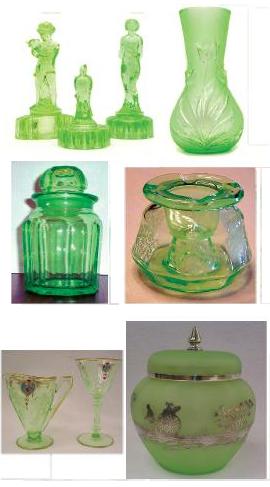 is an unfortunate duplication of the name of the opaque green
color. Light Emerald glassware possessing the Jade decoration
is limited to items from the Everglades line while Forest Green
glassware possessing the Jade decoration is limited to vases
and ball jugs.
is an unfortunate duplication of the name of the opaque green
color. Light Emerald glassware possessing the Jade decoration
is limited to items from the Everglades line while Forest Green
glassware possessing the Jade decoration is limited to vases
and ball jugs.
From a November 2003 article written by Les Hansen, the following table lists ingredients for producing a batch of Light Emerald.
| Ingredient | Quantity (lb) |
| Sand | 850 |
| Soda | 330 |
| Feldspar | 100 |
| Lime | 42 |
| Nitrate | 50 |
| Lead | 36 |
| Arsenic | 10 |
| Copper Oxide | 13 oz |
| Uranium | 43 oz |
Copper oxide and the uranium gave Light Emerald its distinctive color. The other ingredients are common to many other colors of glass.
In 1927, the Cambridge Glass Company introduced its
second opaque green color of glassware. Cambridge glass
collectors have coined the name of Avocado for this additional
green opaque color; however, research suggests Avocado
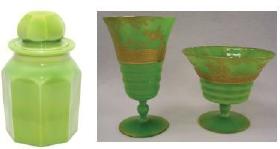 likely was actually called Pomona Green by the Cambridge
Glass Company. Fluorspar (calcium fluoride) is the critical
ingredient added to glass formulas to produce opaque glass.
Avocado was likely produced for only a couple of years and
is one of the more difficult to find among Cambridge glass
colors. Other than Ebony, Cambridge's opaque colors were
seldom etched and gold encrusted, but pieces of Avocado
can be found gold-encrusted Hunt Scene and Dresden Rose.
Because of its specific time period of production, Avocado
can be found in interesting items that cannot be found in the
other opaque colors, including desk sets, blown stemware, the
refectory bowl, and the tobacco jar.
likely was actually called Pomona Green by the Cambridge
Glass Company. Fluorspar (calcium fluoride) is the critical
ingredient added to glass formulas to produce opaque glass.
Avocado was likely produced for only a couple of years and
is one of the more difficult to find among Cambridge glass
colors. Other than Ebony, Cambridge's opaque colors were
seldom etched and gold encrusted, but pieces of Avocado
can be found gold-encrusted Hunt Scene and Dresden Rose.
Because of its specific time period of production, Avocado
can be found in interesting items that cannot be found in the
other opaque colors, including desk sets, blown stemware, the
refectory bowl, and the tobacco jar.
After Henry Hellmers began work as a glass chemist at the
Cambridge Glass Company, he formulated a new color in 1931
called Forest Green, and production of Forest Green continued
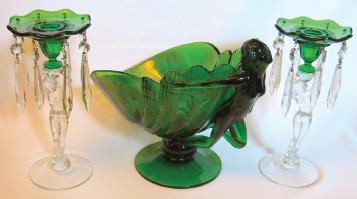 through 1943. Forest Green, Early Dark Emerald, and Late
Dark Emerald (this color will be also be discussed) are very
similar in color. Thankfully, the years of production of the
three dark green transparent colors don't overlap; therefore,
knowing the production date of a specific item can assist in
determining the appropriate color name.
through 1943. Forest Green, Early Dark Emerald, and Late
Dark Emerald (this color will be also be discussed) are very
similar in color. Thankfully, the years of production of the
three dark green transparent colors don't overlap; therefore,
knowing the production date of a specific item can assist in
determining the appropriate color name.
The production dates of a few Cambridge lines extend from the era of Forest Green to that of Late Dark Emerald. Thus, determining the proper color for these items can be difficult. For blown items, Forest Green tends to have a yellowish cast that Late Dark Emerald lacks. For heavy molded pieces, distinguishing between Forest Green from Late Dark Emerald is sometimes extremely difficult. Because of its dark color, Forest Green doesn't allow etchings to easily show up. Nonetheless, a persistent collector can find Forest Green pieces etched Apple Blossom, Blackberry, Bordeaux, Diane, Elaine, Gloria, Lorna, Martha, Minerva, Portia, Rose Marie, Valencia, and Wildflower. Collectors would be fortunate to find one example of each of these etchings on Forest Green.
During the production period of Forest Green (1930's and early
1940's), the Cambridge Glass Company was in its heyday.
Many exciting patterns and shapes were produced in Forest
Green that had not been produced in earlier green colors -- the
flying lady bowl, Mount Vernon, Tally Ho, nude stems, the
frog vase, and the frog pitcher are examples. Although Light
Emerald continued to be used to produce glass into the 1940's,
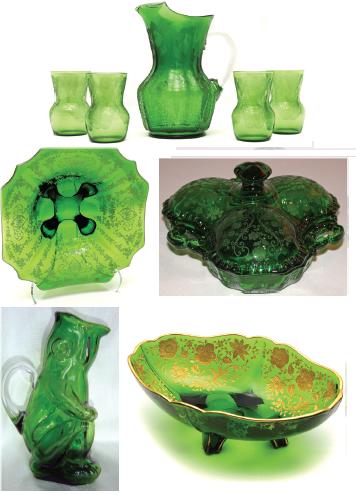 none of the aforementioned items were produced in Light
Emerald. For swan collectors, the Forest Green swans are
quite difficult to find. If you have a 10½" Forest Green swan in
your collection, please consider yourself extremely fortunate.
none of the aforementioned items were produced in Light
Emerald. For swan collectors, the Forest Green swans are
quite difficult to find. If you have a 10½" Forest Green swan in
your collection, please consider yourself extremely fortunate.
In a November 2003 article written by Les Hansen, the following table lists ingredients for Forest Green.
| Ingredient | Quantity (lb) |
| Sand | 800 |
| Soda | 340 |
| Feldspar | 100 |
| Lime | 80 |
| Nitrate | 50 |
| Lead | 40 |
| Borax | 40 |
| Arsenic | 10 |
| Bichromate | 3 |
| Iron Oxide | 2 |
| Copper Oxide | 1 |
Bichromate, iron oxide, and copper oxide are the ingredients that give Forest Green it distinctive color.
In 1938, the Cambridge Glass Company introduced Pistachio
for the first time. Pistachio was produced during two time
periods – 1938 to 1943 and 1955 to 1958 – and glassware
produced during the two periods is sometimes referred to
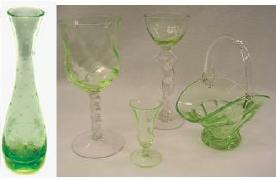 as "Early" Pistachio and "Reopen" Pistachio (indicating the
glass was produced after the reopening of the Cambridge
Glass Company in 1955). The items produced in Pistachio are
rather limited compared to other Cambridge colors of that time
period. Early Pistachio was most common in the Caprice line,
and all #300 blown Caprice stemware blanks were produced in
Early Pistachio, as well as the cup & saucer, salad plate, dessert
plate, 11½" service plate, medium size creamer & sugar. A
few additional Caprice items were produced. Pistachio was
also one of the colors used in the Varitone drink ware sets;
therefore, many of the Early Pistachio pieces are drinking
vessels.
as "Early" Pistachio and "Reopen" Pistachio (indicating the
glass was produced after the reopening of the Cambridge
Glass Company in 1955). The items produced in Pistachio are
rather limited compared to other Cambridge colors of that time
period. Early Pistachio was most common in the Caprice line,
and all #300 blown Caprice stemware blanks were produced in
Early Pistachio, as well as the cup & saucer, salad plate, dessert
plate, 11½" service plate, medium size creamer & sugar. A
few additional Caprice items were produced. Pistachio was
also one of the colors used in the Varitone drink ware sets;
therefore, many of the Early Pistachio pieces are drinking
vessels.
In 1955, "Reopen" Pistachio was introduced. Because Cambridge was producing a much more limited number of items during the reopened period, those items produced in "Reopen" Pistachio are quite easily identified, including the 3011 short-stemmed nude comport and the #1528 vase. "Reopen" Pistachio is slightly darker than its earlier version and, if not frequently washed, the glass acquires a foggy cast. All items with the crackled treatment are "Reopen" Pistachio.
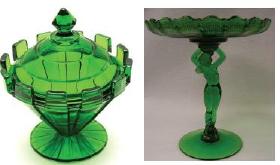 In 1949, the Cambridge introduced yet another color called
Emerald. To limit confusion, collectors refer to this color as
Late Dark Emerald. This color was very reminiscent of Early
Dark Emerald and Forest Green. If the production time of a
particular item is known, then assigning the correct transparent
dark green color to that item can be fairly easy. However,
when the production period of an individual item overlaps
the production period of the transparent green colors, correct
identification of the dark green color can be difficult. For
example, the production periods of a few lines spanned across
the entire 1940's (from Forest Green to Late Dark Emerald),
including Jefferson, Georgian, Sea Shell, Caprice, and nude
stems. The number of items produced solely in Late Dark
Emerald is somewhat limited and include Cascade, Pristine,
and type 3 swans.
In 1949, the Cambridge introduced yet another color called
Emerald. To limit confusion, collectors refer to this color as
Late Dark Emerald. This color was very reminiscent of Early
Dark Emerald and Forest Green. If the production time of a
particular item is known, then assigning the correct transparent
dark green color to that item can be fairly easy. However,
when the production period of an individual item overlaps
the production period of the transparent green colors, correct
identification of the dark green color can be difficult. For
example, the production periods of a few lines spanned across
the entire 1940's (from Forest Green to Late Dark Emerald),
including Jefferson, Georgian, Sea Shell, Caprice, and nude
stems. The number of items produced solely in Late Dark
Emerald is somewhat limited and include Cascade, Pristine,
and type 3 swans.
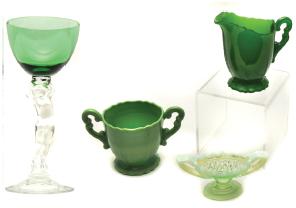 An undocumented transparent green is sometimes referred
to as "Odd" Green has surfaced in seven items: #1327 favor
vase, Stradivari cocktail, Stradivari cordial, #3011 nude
cocktail, #3011 nude brandy #496 little joe tumbler, and
#1341 cordial. This color can best be described as teal.
Often stems or tumblers found in Odd Green are part of a
Harlequin or Varitone set; therefore, the production dates of
Odd Green center about the production dates of these drinking
sets. Surprisingly, neither a #1955 tumbler nor a #496 tall joe
tumbler has been spotted in Odd Green.
An undocumented transparent green is sometimes referred
to as "Odd" Green has surfaced in seven items: #1327 favor
vase, Stradivari cocktail, Stradivari cordial, #3011 nude
cocktail, #3011 nude brandy #496 little joe tumbler, and
#1341 cordial. This color can best be described as teal.
Often stems or tumblers found in Odd Green are part of a
Harlequin or Varitone set; therefore, the production dates of
Odd Green center about the production dates of these drinking
sets. Surprisingly, neither a #1955 tumbler nor a #496 tall joe
tumbler has been spotted in Odd Green.
The Cambridge Glass Company periodically produced experimental colors. Most of these colors can be seen in the Experimental Glass case in the National Museum of Cambridge Glass. Several of experimental colors produced are a shade of green.
A very special "Thank You" to the following Friends of Cambridge who contributed photos for the "Shades of Green" article
Sue Cameron
Glenn & Kathy Corbett
David Ray
Linda Roberts
Cher Van Soest
Wendy Steelhammer
Jack & Elaine Thompson
Frank & Vicki Wollenhaupt
